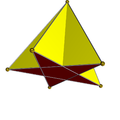Pyramid (geometry)
| Set of pyramids | |
|---|---|
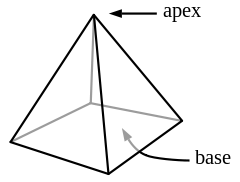 |
|
| Faces | n triangles, 1 n-gon |
| Edges | 2n |
| Vertices | n + 1 |
| Symmetry group | Cnv |
| Dual polyhedron | Self-dual |
| Properties | convex |
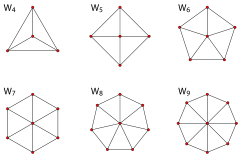
- This article is about the polyhedron pyramid (a 3-dimensional shape); for other versions including architectural pyramids, see Pyramid (disambiguation).
In geometry, a pyramid is a polyhedron formed by connecting a polygonal base and a point, called the apex. Each base edge and apex form a triangle. It is a conic solid with polygonal base.
A pyramid with an n-sided base will have n + 1 vertices, n + 1 faces, and 2n edges. All pyramids are self-dual.
When unspecified, the base is usually assumed to be square.
If the base is a regular polygon and the apex is above the center of the polygon, an n-gonal pyramid will have Cnv symmetry.
Pyramids are a subclass of the prismatoids.
Contents |
Pyramids with regular polygon faces
The regular tetrahedron, one of the Platonic solids, is a triangular pyramid all of whose faces are equilateral triangles. Besides the triangular pyramid, only the square and pentagonal pyramids can be composed of regular convex polygons, in which case they are Johnson solids.
| Tetrahedron | Square pyramid | Pentagonal pyramid |
|---|---|---|
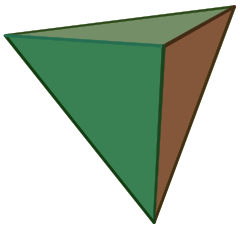 |
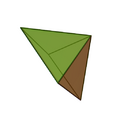 |
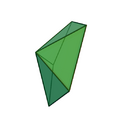 |
Star pyramids
Pyramids with regular star polygon bases are called star pyramids. For example, the pentagrammic pyramid has a pentagram base and 5 intersecting triangle sides.
Volume
The volume of a pyramid is  where B is the area of the base and h the height from the base to the apex. This works for any location of the apex, provided that h is measured as the perpendicular distance from the plane which contains the base.
where B is the area of the base and h the height from the base to the apex. This works for any location of the apex, provided that h is measured as the perpendicular distance from the plane which contains the base.
The formula can be formally proved using calculus: By similarity, the dimensions of a cross section parallel to the base increase linearly from the apex to the base. Then, the cross section at any height y is the base scaled by a factor of  , where h is the height from the base to the apex. Since the area of any shape is multiplied by the square of the shape's scaling factor, the area of a cross section at height y is
, where h is the height from the base to the apex. Since the area of any shape is multiplied by the square of the shape's scaling factor, the area of a cross section at height y is  . The volume is given by the integral
. The volume is given by the integral
The volume of a pyramid whose base is a regular n-sided polygon with side length s and whose height is h is therefore:
The volume of a pyramid whose base is a regular n-sided polygon with radius R is therefore:
This property can be used to derive the volume for cones, as well. See also cone.
Surface area
The surface area of a pyramid is  where B is the base area, P is the base perimeter and L is the slant height.
where B is the base area, P is the base perimeter and L is the slant height.
See also
- Bipyramid
- Cone (geometry)
- Trigonal pyramid (chemistry)
- Frustum
External links
- Weisstein, Eric W., "Pyramid" from MathWorld.
- Olshevsky, George, Pyramid at Glossary for Hyperspace.
- The Uniform Polyhedra
- Angle between surfaces of a pyramid (general analytical solution), with pyramid dimensioning calculator
- Virtual Reality Polyhedra The Encyclopedia of Polyhedra
- VRML models (George Hart) <3> <4> <5>
- Paper models of pyramids
|
||||||||||||||||||||||||||
